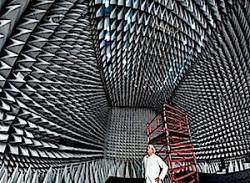With the debacle surrounding LightSquared’s now-stymied proposal still reverberating through Washington, federal agencies are studying ways to repurpose the spectrum adjacent to the satellite navigation frequencies without causing debilitating interference to GPS receivers.
With the debacle surrounding LightSquared’s now-stymied proposal still reverberating through Washington, federal agencies are studying ways to repurpose the spectrum adjacent to the satellite navigation frequencies without causing debilitating interference to GPS receivers.
Officials at the Department of Transportation (DoT) have completed a new study on how much power can be transmitted in the neighboring bands without bollixing GPS users, said Karen Van Dyke, acting director of position, navigation and timing at the Volpe National Transportation Systems Center in DoT’s Research and Innovative Technology Administration (RITA).
“We never really defined the characteristics of what our good (GPS) neighbor would look like,” Van Dyke told the September 18 meeting of the Civil GPS Service Interface Committee (CGSIC) in Nashville, Tennessee. To do that, RITA and the Federal Aviation Administration (FAA) worked together to complete a capability assessment, she said.
“So really, we’re going to define what is the maximum aggregate power that can exist in an adjacent band [so as] to not interfere with all the existing GPS receivers that we expect to still be operating into the future,” Van Dyke said.
The study, which was requested by Deputy Secretary of Transportation John Porcari, also looked at “future GNSS” service and receivers. Porcari represents the civil community as co-chair of the U.S. National Space-Based Positioning, Navigation and Timing (PNT) Executive Committee (ExCom),
RITA is now working out how to integrate the results.
“We just completed a plan that’s been delivered to the [DoT] deputy secretary and we’re basically putting the processes in place on how were going to implement that plan. That is going to involve the GPS industry,” said Van Dyke. “We want to make sure that is a public, transparent process.”
While DoT is studying power limits for adjacent frequencies as a way to limit interference, the National Telecommunications and Information Administration, or NTIA is chairing a technical task force on the issue.
The task force was initiated by the ExCom and is a follow-through on an ExCom proposal, made by the ExCom in a January 13 letter about LightSquared test results, to “draft new GPS Spectrum Interference standards.”
“The purpose of developing new standards is to better inform future proposals for high-power terrestrial broadband services in the bands adjacent to GPS while also ensuring these proposals do not affect vital PNT services,” said Tony Russo, the director of the National Coordination Office (NCO) for Space Based PNT, in an emailed response.
“In March, the NCO presented six options to the ExCom’s Executive Steering Group (ESG) on how to approach the building of new standards,” said Russo. “At that briefing, the Executive Steering Group established a Technical Task Force (TTF) to assess feasibility of accommodating a terrestrial broadband system adjacent to the GPS L1 signal. The ESG asked NTIA to chair the TTF and the ExCom member agencies provided technical experts to support the work.”
Though the ExCom language did not specify how to address interference, the FCC and NTIA appears to be leaning more towards setting standards for GPS receivers so that they will be able to operate despite the presence of interfering signals. On February 14, when NTIA administrator Lawrence Strickling wrote to the FCC saying the LightSquared project was not practical, he urged the FCC to “explore appropriate actions to mitigate against the impact GPS and other receivers may have to prevent the full utilization of spectrum to meet the nation’s broadband needs.”
The final choice between limiting signals in nearby bands or requiring tougher GPS receivers is likely to determine, at least in part, who ultimately bears more of the financial burden for opening up the spectrum.
The TTF has already started meeting — though an NTIA spokeswoman said the next meeting has been delayed. There is no specific target date for completion of the work and, thus far, the group is limited to government technical experts — although that is expected to change.
“They will open to industry at some later date, though I don’t know when that will be,” said Russo. Specifically, the task force plans to seek public comment on any accommodation proposals through one or more Federal Register Notices, he said.
“We do absolutely recognize the increasing demand for spectrum and that [the GPS adjacent] band certainly may be repurposed in the future,” Van Dyke told the CGSIC.
Dee Ann Divis is an editor at the Washington Examiner in Washington D.C. She writes the Washington View column for Inside GNSS.





